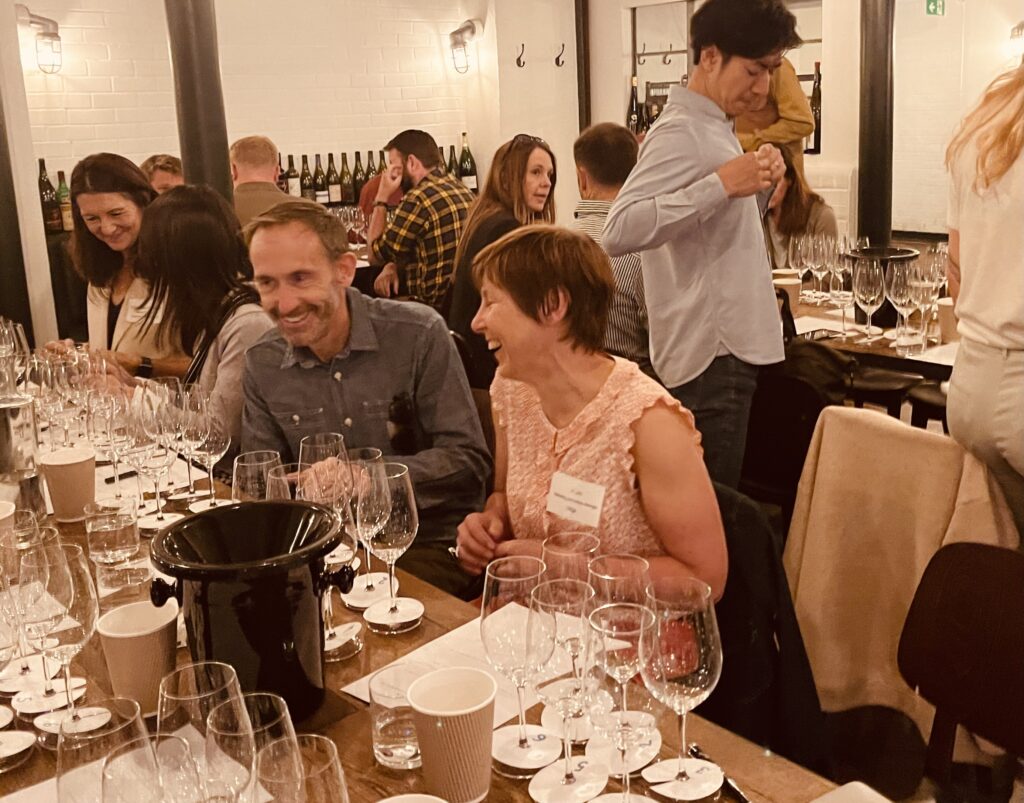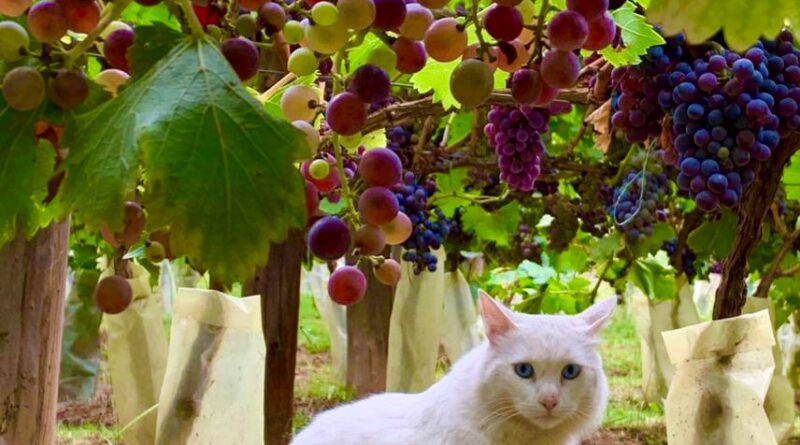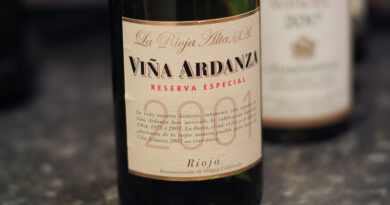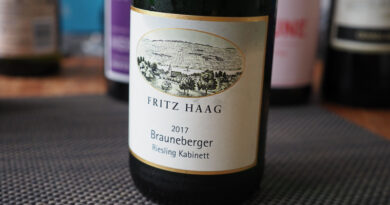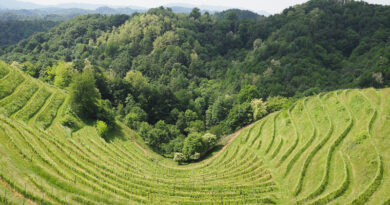Exploring Argentina’s diversity and quality, with Paz Levinson
There isn’t enough Argentine wine on our lists says Argentinian Sommelier Paz Levinson. She came to London to show a diverse range of wines at Fare Restaurant for Argentina Reloaded. Only 6 were Malbecs. Half were white, and all were world class.
Lisse Garnett reports.
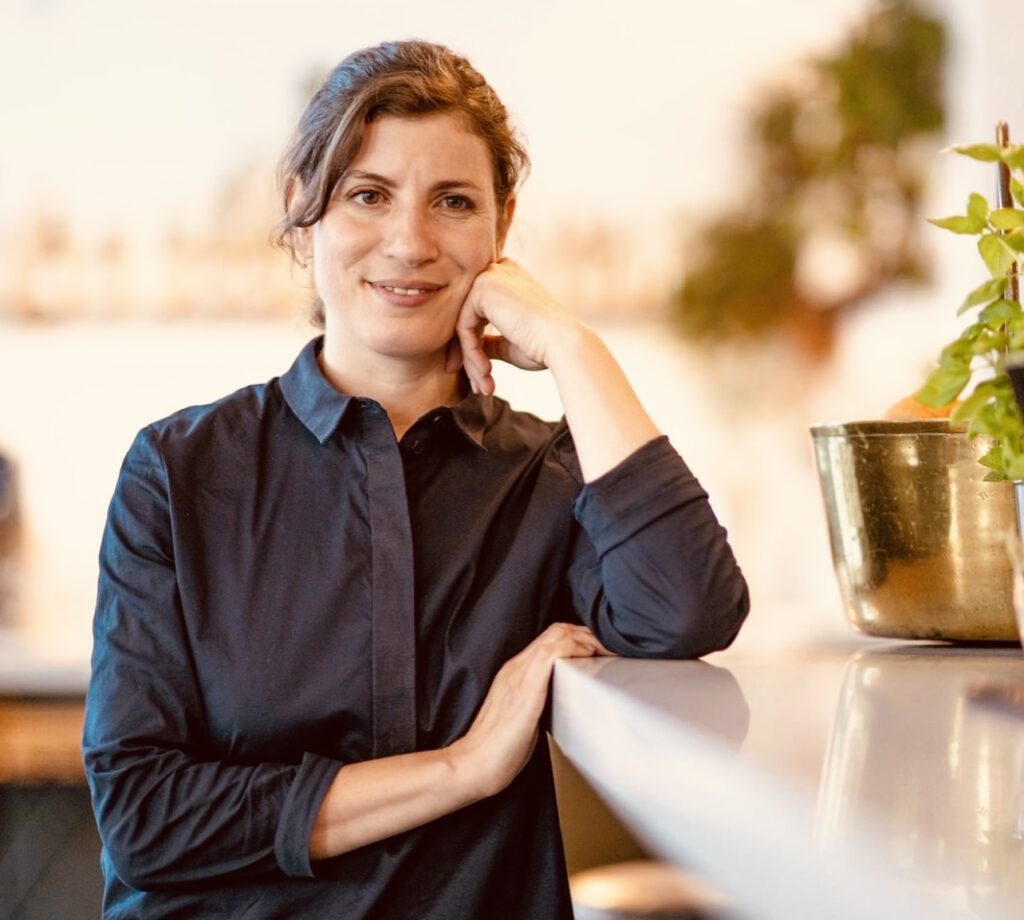
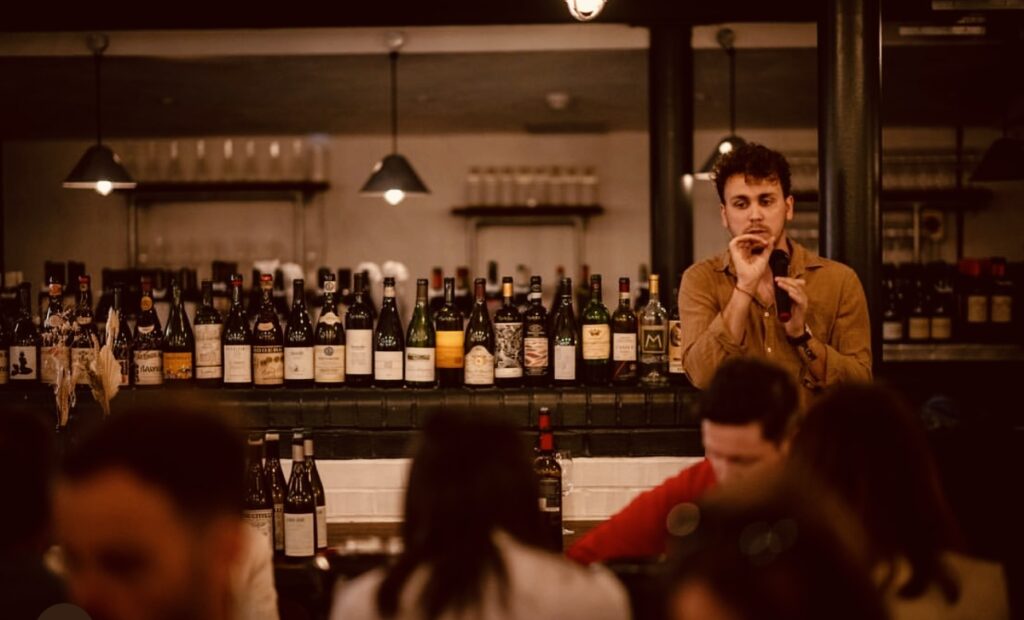
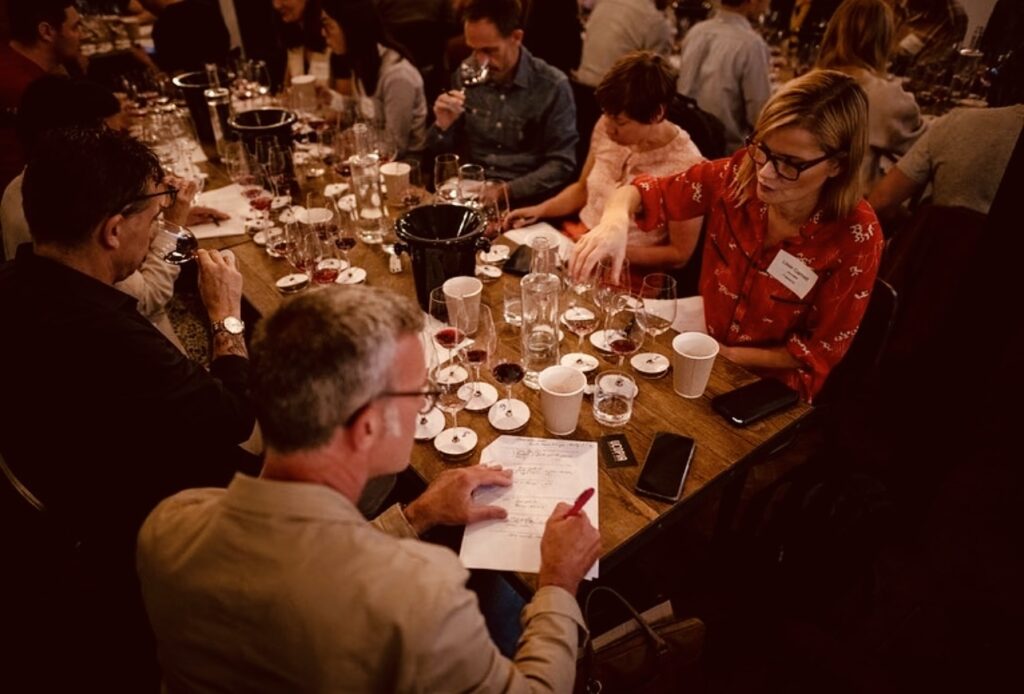
Argentinian wine has journeyed far in the past 30 years. In the 90s wine investment boomed, heavy oak was in and flying winemakers were everywhere. Today the vineyards have expanded and migrated north, south, east and west. Emphasis is no longer on red wine – but also very much on white. Big players like Catena and mid-sized players like Susana Balbo are acting small – farming responsibly, often organically, paying fair prices for grapes, irrigating carefully and even making low intervention orange wines. This, says Paz, is indicative of real and lasting change in Argentina.
As we in the UK struggle with 9.4% inflation, spare a thought for those in Argentina where inflation is running at 60% a year. Yet says Phil Crozier of Wines of Argentina, many age-worthy Argentine wines are cheaper today than they were ten years ago. He agreed that on fine wine lists there is a lack of Argentinian offerings and yet, he says, they are often better, both in terms of taste and cost. 75% of Argentina’s wine is consumed at home, a healthy domestic market has been key to survival and the WSTA reported a 41% growth in the UK market for Argentine wine in 2020. Bulk wine too is doing very well and in the mid market, restaurants and pubs continue to trust Argentinian offerings. But says Phil, at the high end Michelin restaurant level, despite infamous 100 point scores, Argentine wine is not well represented except perhaps by Zuccardi and Catena. Restaurants have had a difficult time over the past two years and may well be running down stock. Crozier thinks it will take a long time before Argentina breaks through to Super Tuscan, Burgundy and Bordeaux territory but he believes it WILL happen. ‘The wines are definitely there’, Phil Crozier.
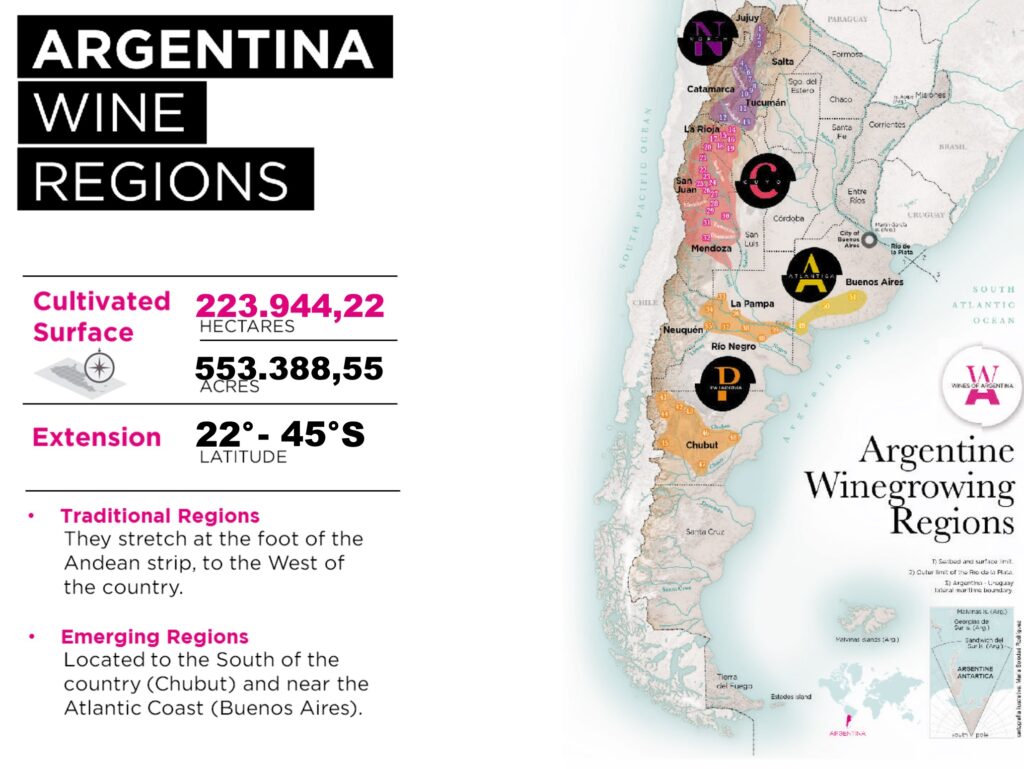
Paz Levinson is from Patagonia in the far South of Argentina, a region governed by both Argentina and Chile. Patagonia is a fascinating place that was inhabited by numerous indigenous tribes at the time of the Spanish arrival in the 16th Century. Initially Spanish explorers had imagined the wide river delta Río de Plata near present day Buenos Aires to be a water passage to Asia. Rumours of a wealth of silver even gave rise to the name Argentina.
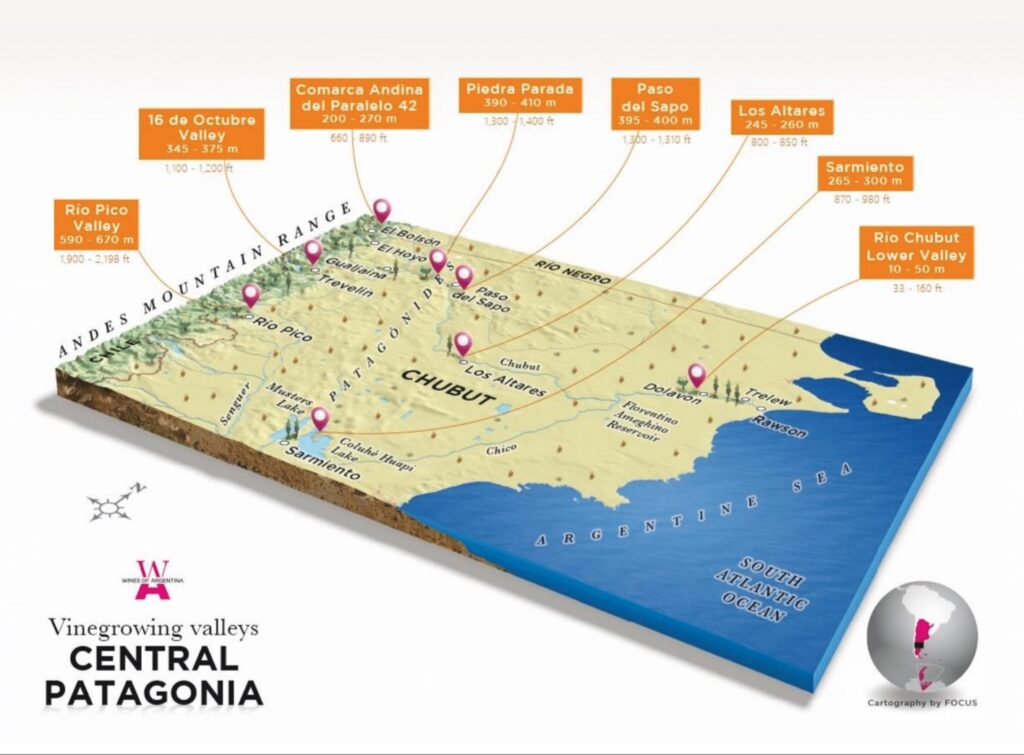
Down South in Patagonia the region is dominated by the southern section of the Andes Mountains that run along the spine of both Chile and Argentina, forming a political and physical boundary. This magnificent mountain range is the result of the convergence of tectonic plates creating unimaginable pressure and buckling. The Andes are situated where the South American plate, the Nazca and the Antarctic plates meet. Cool Patagonia is buffeted by the Pacific to the west and the Atlantic to the east. There are three navigable passages between the Pacific and Atlantic Oceans: Drake, Beagle and the Straights of Magellan.
Beagle was named after the ship HMS Beagle, on which a young Charles Darwin travelled as an amateur naturalist in 1833. Darwin eloquently describes this beautiful region dominated by glaciers, forests and fjords in his research journals. Today this region offers a new frontier – a winemaking frontier, for it is here that the worlds southernmost vineyards are found, slightly further South than those in Central Otago New Zealand.
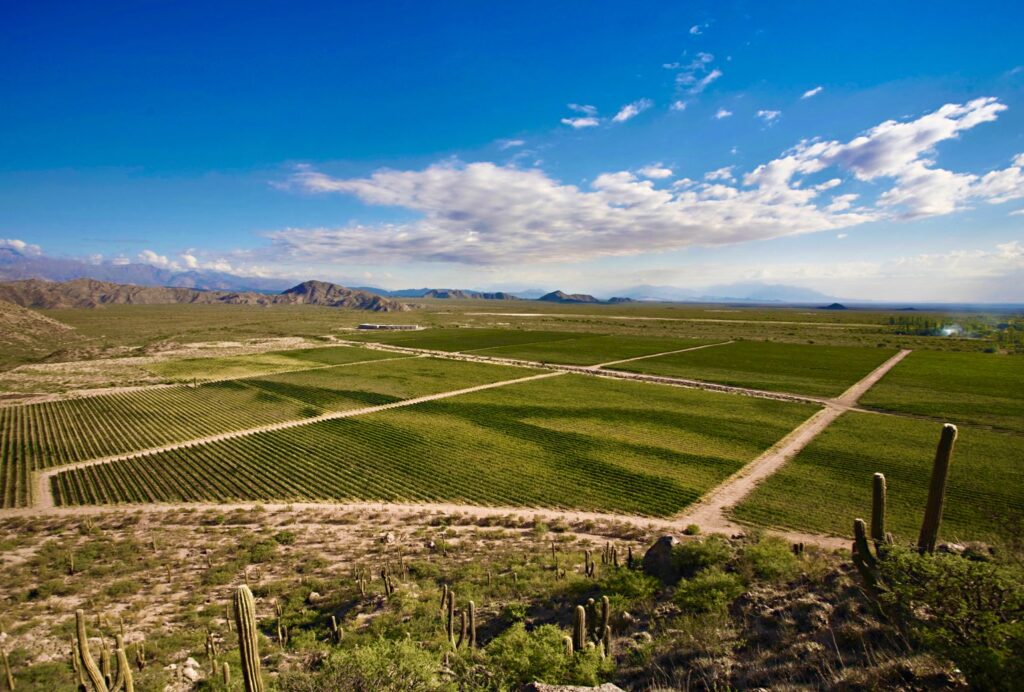
Paz Levinson left Argentina to work in France in 2012. Notes on the wines we tried follow…
Paz Levinson: Argentina is the fifth largest producer of wine in the world. We are far away yes but we are definitely also doing something wrong when it comes to showing our wines. Sometimes we are not represented in restaurants and I want to know why that is.
Sémillon in Mendoza has a long history and these are some of the best Argentina has to offer. The flying winemakers arrived in the 1990s and they were big producers of red wine. Michel Rolland from Pomerol and Roberto Cipresso From Tuscany were both red wine producers, aside from perhaps a touch of Chardonnay.
Today there is a real white revolution going on in Argentina. This has happened before in the 1980s when a lot of Malbec was uprooted because it wasn’t productive enough, in order to supply the demand for whites. Some winemakers have also told me that they even remember Malbec being used to create a white wine too at that time.
Now things are changing and we have a lot of white grapes being planted in Argentina, 30% of the new plantings are white, today you can taste some examples of these. Lisse Garnett’s notes are included here as well as technical sheets on every wine tasted.
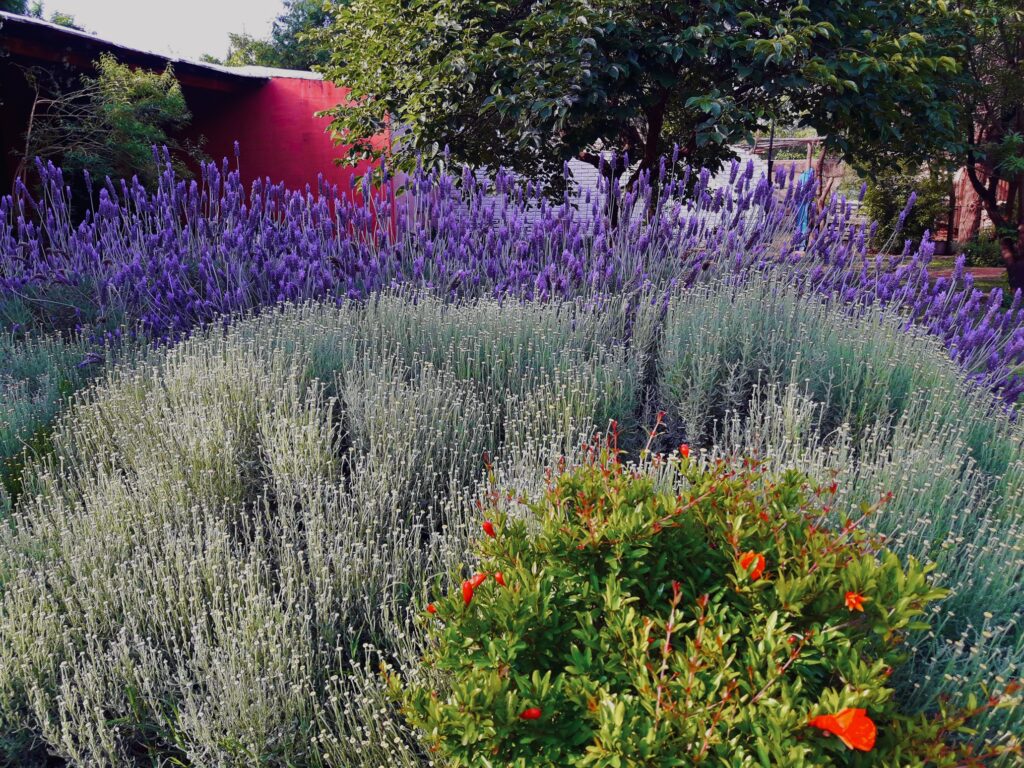
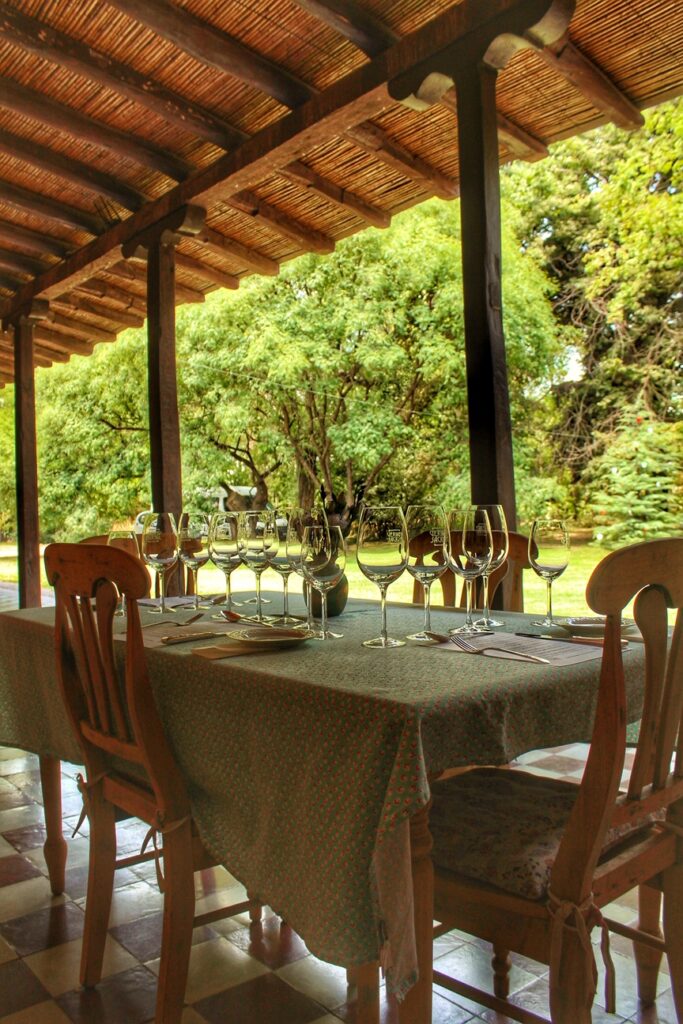
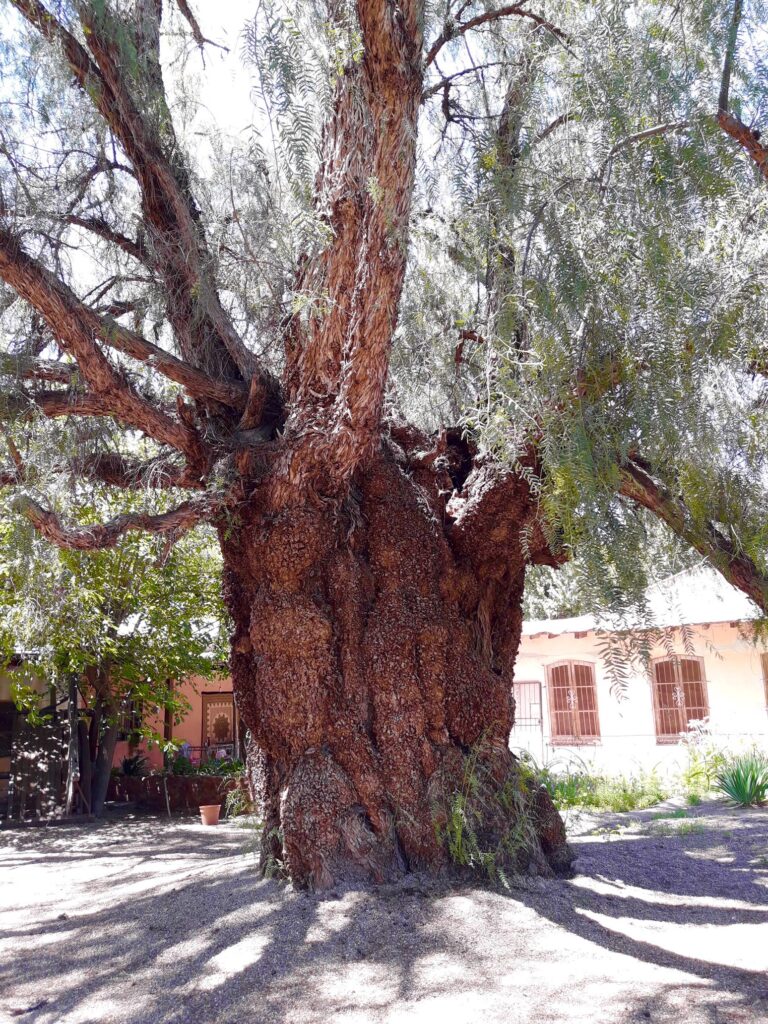
WHITE WINES
Mundo Revès, Le Petit Voyage Blend de Blancas 2020, Gualtallary, Los Chacayes, Uco Valley, Mendoza. RRP £13.00
38% Semillon – 37% Tokaij – 25% Sauvignon Blanc. Made by Frenchmen Quentin & Thibault (Tibo) Lepoutre in Chacayes, an area in Mendoza near the Tutunan River, who moonlight with this their own label and work by day for François Lurton at Piedra Negra. This blend of whites is from different regions. Each variety is fermented separately on skins.
Notes Lisse Garnett: Dry and slightly tannic, this wine is deliciously complex and layered with sour grapefruit, mandarin, burnt orange, pears and sour lemon. A delicious finale of lasting succulent Cointreau and almond. 90
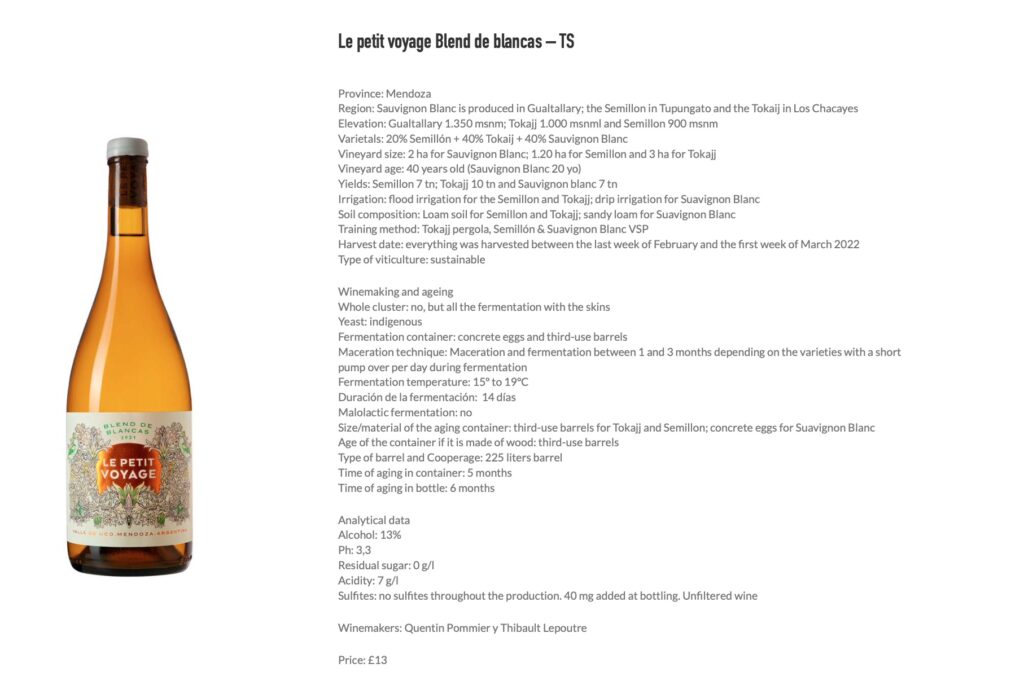
Finca Suarez, Semillón 2021, Paraje Altamira, San Carlos, Mendoza. RRP £33.00
Finca Suarez in Paraje Altamira has been a GI since 2013 and was the first geographical indication made by the terroir and not by politics. Juanfa Suarez’s Ampelographer Grandad wrote about Semillon here a long time ago. Juanfa was in a rock band but today he has a tiny winery and produces everything by hand on this calcareous soil, full of chalk.
LG: Cloudy, pale lemon in colour. Salty – superbly textural with sour lemon and grapefruit layers, sherbet pips and yoghurt plus a delicious delicate hint of mandarin. Long, elegant, sapid, moreish and truly delicious. 93
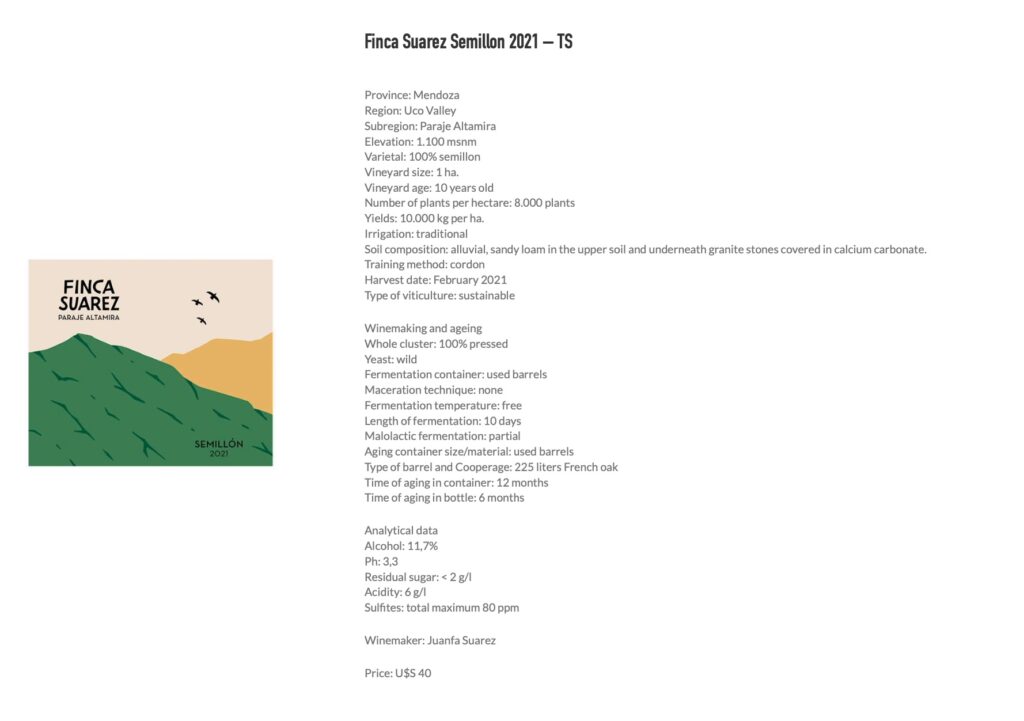
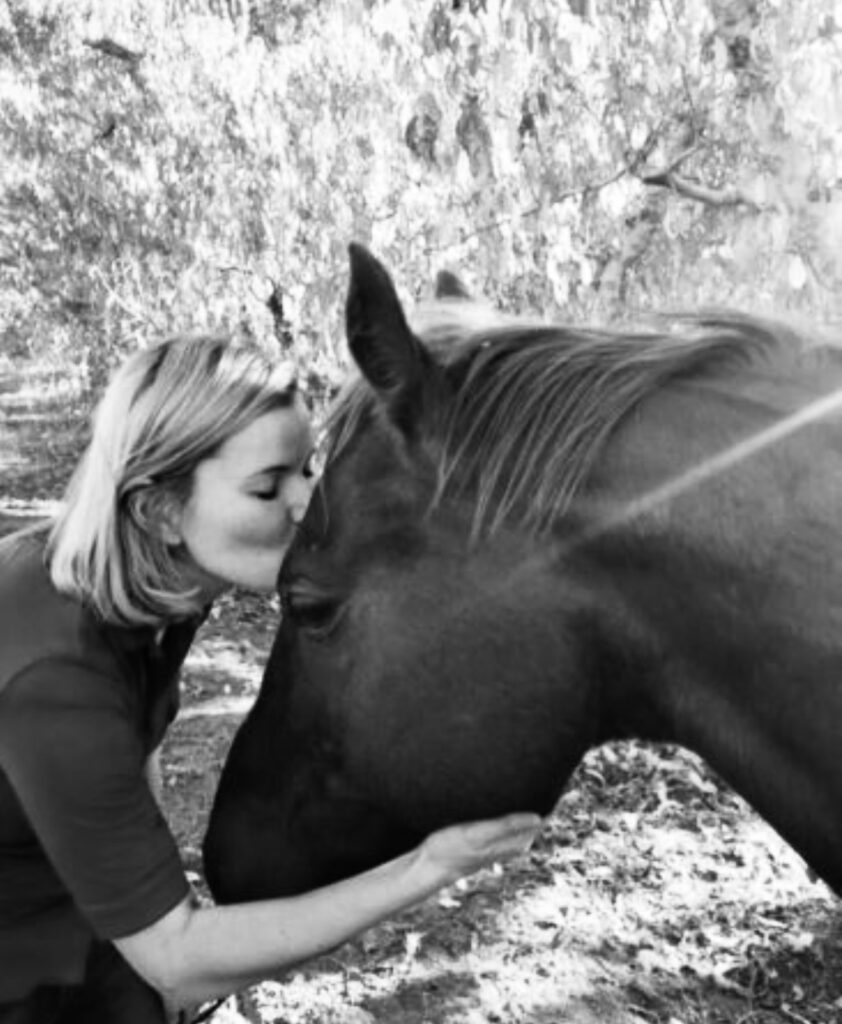
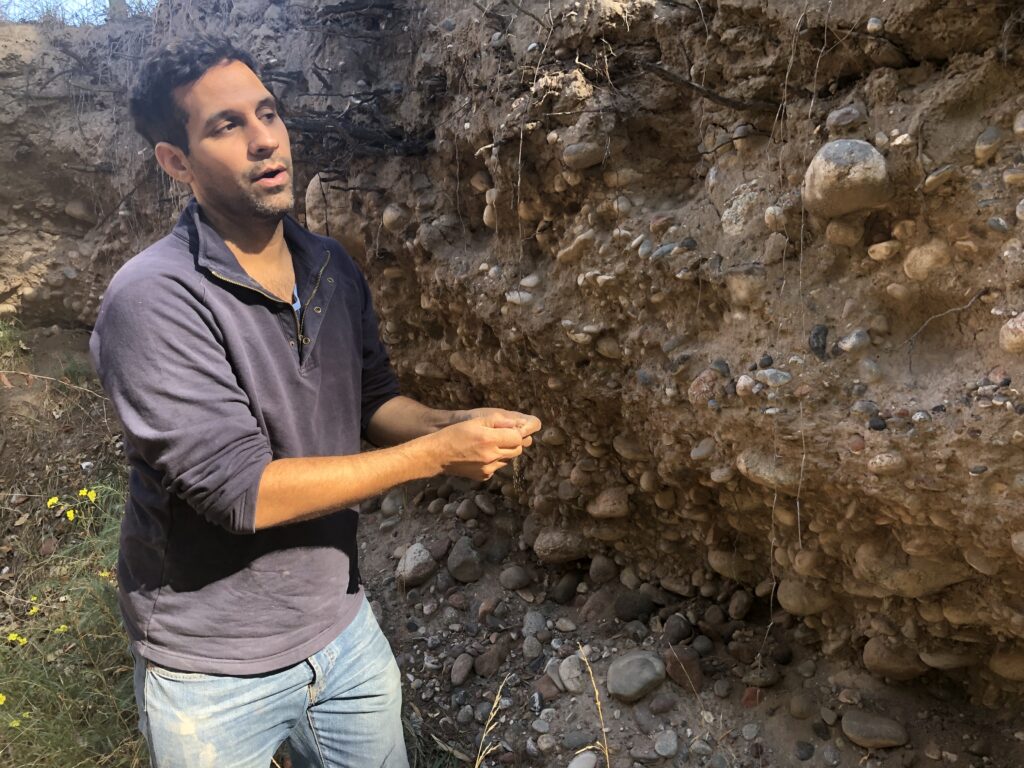
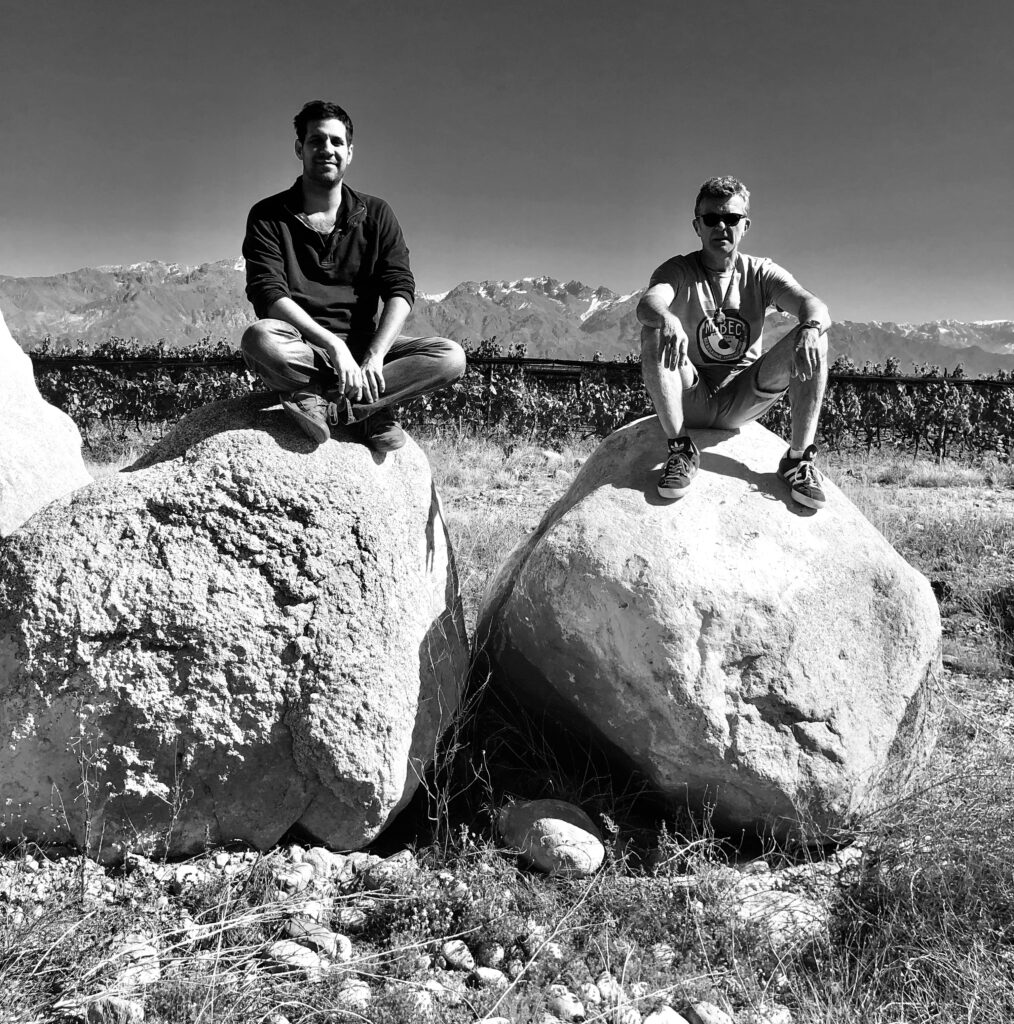
Michellini I Muffato, Certezas Semillon 2020, El peral, Tupungato, Mendoza RRP £60.00
‘I work in the winery, my father, my mother and me. It is a very old vineyard, planted in 1891. The winery is simple – we press and we avoid oxidation and all of the juice goes to a 1000 litre foudres for two years on the lees. We try to make a wine that will age for some time. The most important thing is the vineyard, planted by massal selection pre phylloxera – so we have a beautiful selection of pre-phylloxera vines. We have three brothers of whites, this wine and a Chardonnay and a Chenin Blanc.’
Manuel Michellini at Fare London 2022
LG: Gerardo Michellini and Andrea Muffato have done it again. Seriously textured – some tongue puckering from skin contact in this superbly structured white from the pair who managed to scoop the Best White Wine of the year with the 2019 vintage of this wine in Tim Atkin’s 2022 Special Report. Grapefruit, mandarin, beeswax, candied lemon, toffee apple and peach – a supremely long silky texture. Creamy and dreamy. 96
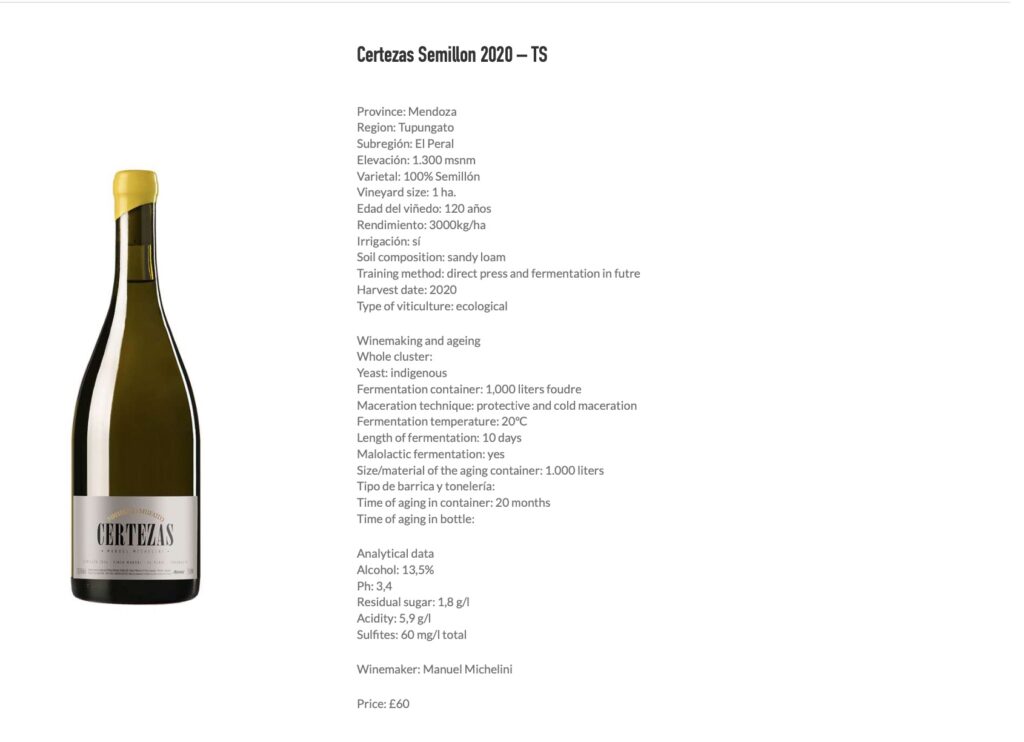
Catena La Marchigiana, Moscatel 2020, El Mirador, Rivadavia, Mendoza RRP £25.00
Paz: This Moscatel is produced by a big producer by Catena Zapata – Mendoza – I wanted to show you this skin contact wine, it’s made in a very simple way – without sulfites in clay amphoras with organic vineyards. I think it’s important to note that if the big producers are prepared to change then all the industry might be prepared to change too. Pro-quality and looking to pay a fair price for the grapes. These grapes come from a very old vineyard. Wine is blended vineyard by vineyard and not in bulk. Here we see a very nice textured Moscatel.
LG: Golden rose-hued skin contact textural white with a delicious fino sherry note. Pear, red apple, sour lemon and mandarin. Silky, salty, sapid, satin smooth and sensual on the tongue, tipped with saline. 90
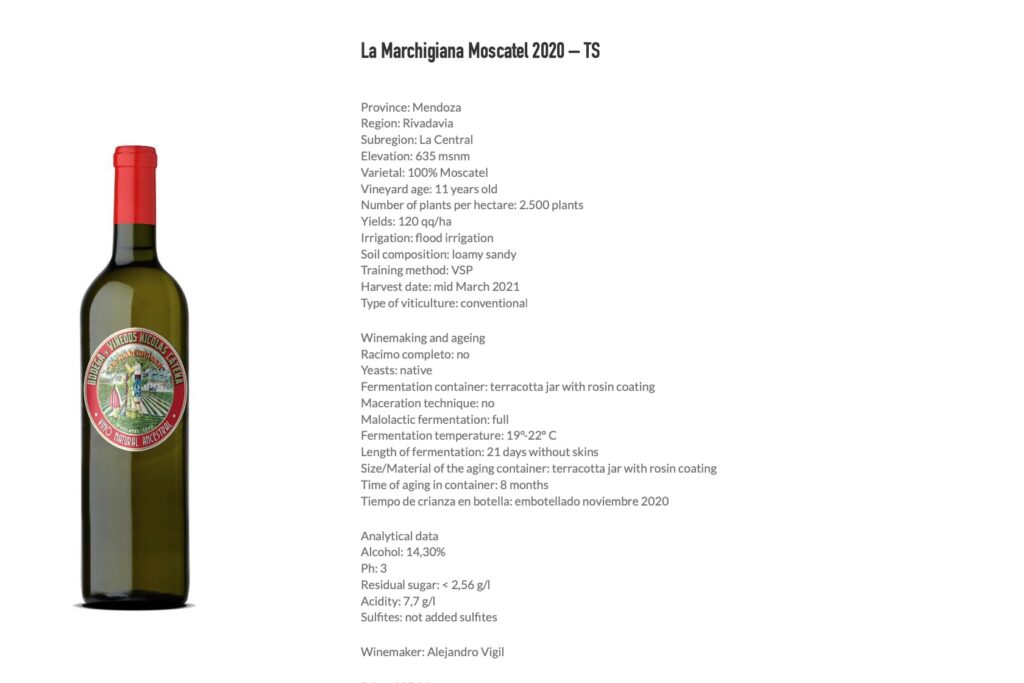
Paz: This is Torrontés from Mendoza, not from Salta, very floral, not so much skin contact, it’s not an extreme orange wine – I think Torrontés is a very good grape for skin contact, it does fantastically but when I started in the industry we learned that Torrontés has to be separated from the skins as fast as possible! If not, we were told, it’s going to be very bitter – but you see how the techniques change and also how the exploration of the techniques influences winemaking, this is how Torrontés used to be made. – You get thyme, wax, you get other fantastic aromas. A medium sized producer, Susana Balbo founded her winery in 1999 and works with skilled winemaker Edy del Popolo. This wine is certified organic.
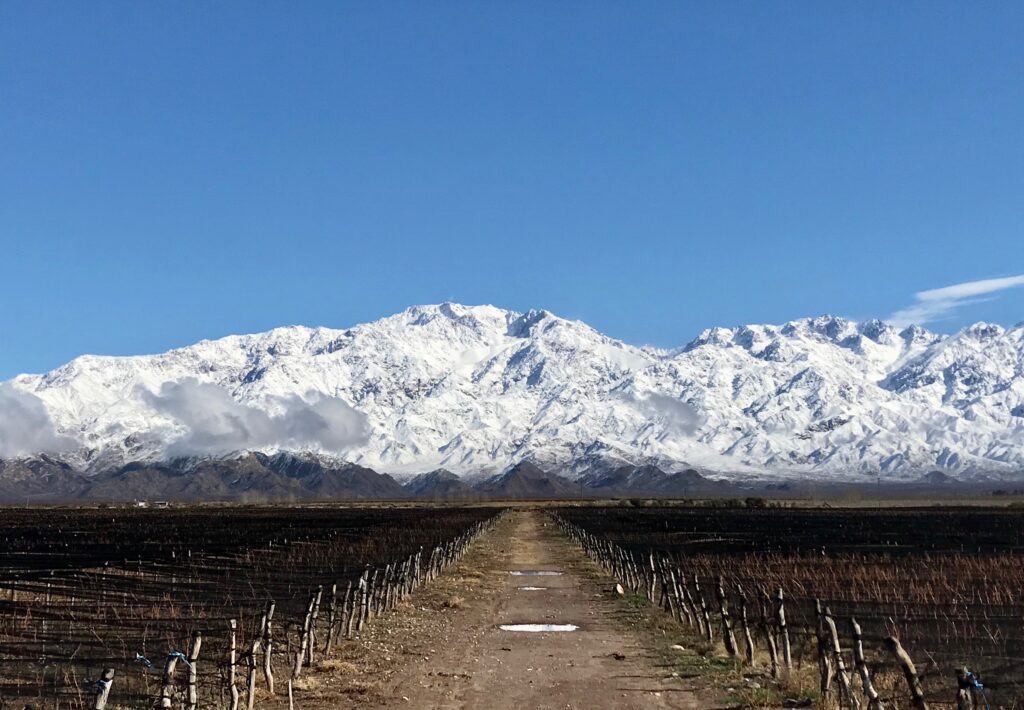
Susana Balbo, Edición Limitata Torrontés Naranjo de Raíz, Paraje Altamira, San Carlos, Mendoza RRP £39.00
LG: Orange wine reeking of beeswax furniture polish, sinsemilla and leather. A salted mandarin, pine-scented, nutty pear and almond textured feast. Long and layered, complex and chewy – Fantastic 94
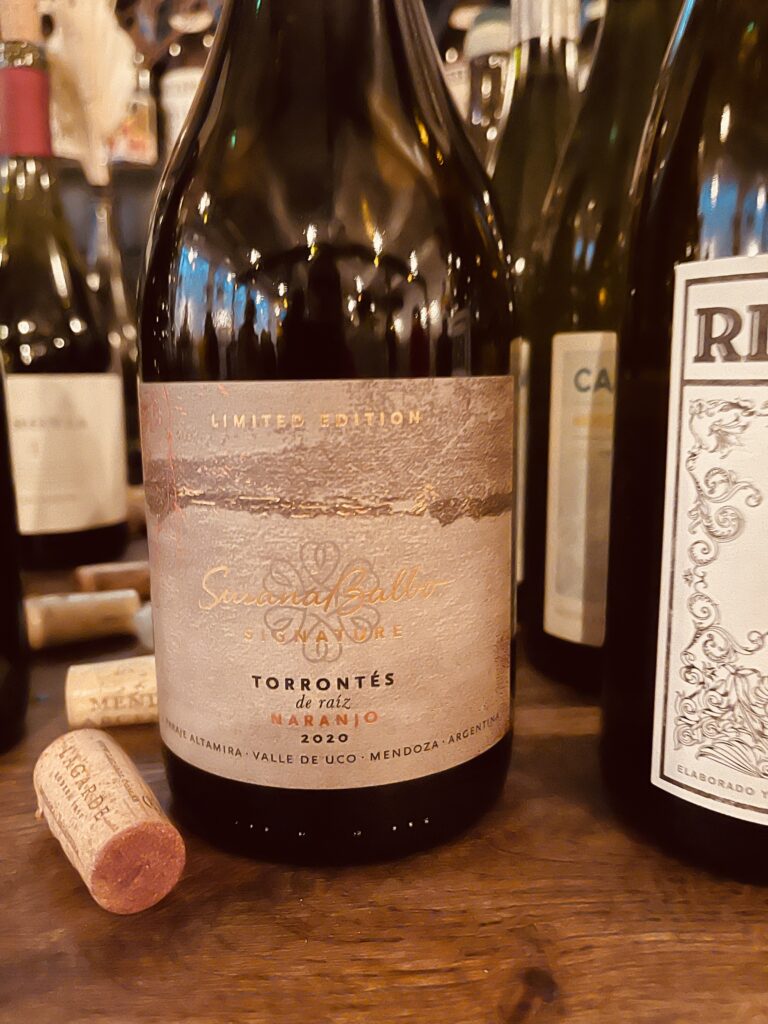
Otronia 45 Rugientes Corte de Blancas 2019 – Chubut, Sarmiento
LG: 13.2% Alcohol. Viscous and roundly Rubenesque. Layers of salty grapefruit, rose petal, ginger, grapefruit and succulent sapid peach – It’s deliciously long and full. Magnificent. 96
Paz: Very special because it comes from a new region in Argentina, Chubut, South of Chubut, 2000 km south of Mendoza. Winemaker Juan Pablo Murgia says the most important thing are the conditions, it’s a very cool place, that defines the freshness acidity and saltiness, very windy – a lot of sunlight in these extreme conditions, blend of Chardonnay, Gewürztraminer and Pinot Gris. An organic wine, aged for two years in oak foudres of 5000 litres.
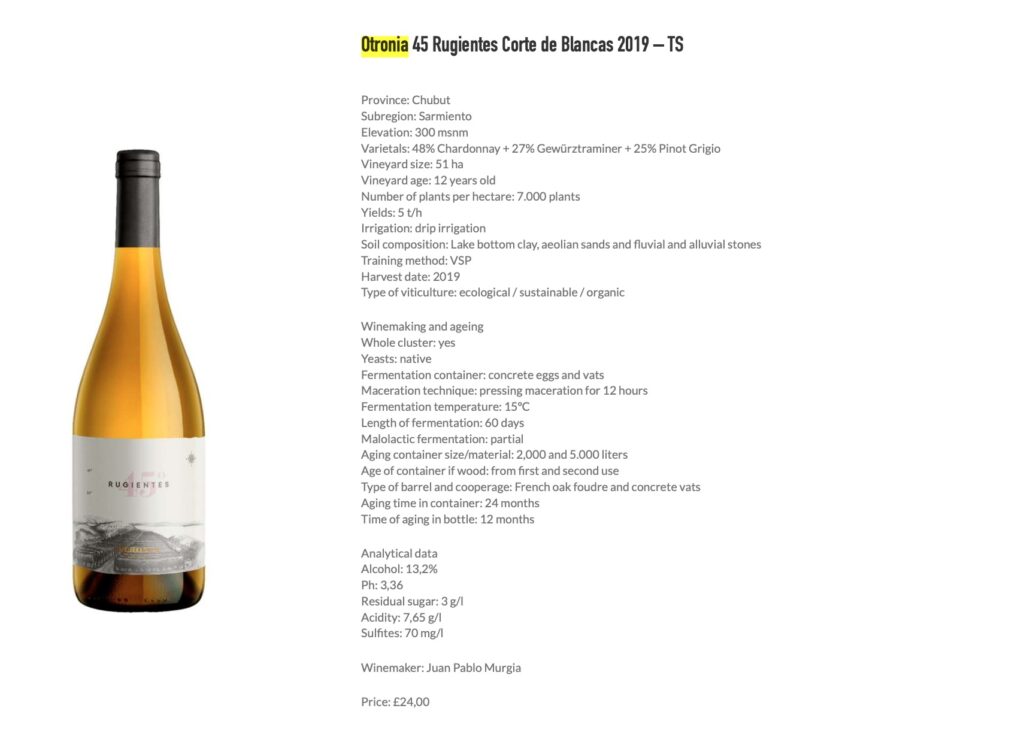
RED WINES
Paz: This is a flight of different reds, not Malbec from different regions. We begin with Juan Pablo’s Pinot from Chubut. The first time I went there was ten years ago, I knew that something was happening at this lake, this enormous lake near Sarmiento. I am from Patagonia, from Bariloche in Patagonia and this place is 1000 km south of there. I knew something was happening there because Pedro Parra the world renown expert in soil and wine terroir had been visiting Chubut. The population there is tiny, you have one inhabitant per square kilometre. It’s extremely windy, the lake is like a sea. There are 50 hectares planted in this place, organically farmed.
‘We feel this wine has the deepest and strongest character of the place it comes from’ ‘it is an expression of an extreme place’ Juan Pablo Murgia
Otronia, 100% Pinot Noir 2019, Sarmiento, Chubut RRP £47.00
LG: This wine comes from the coolest and most southerly commercial vineyard in Argentina, 1,131 km from Neuquén, 50 hectares divided into small blocks by soil type. Purple and garnet coloured. Ripe strawberry, cherry wiśnówka and kirsch on the nose, fragrant and perfumed more subdued on the palate, more earthy with silty tannins – grainy. Long 91
Paz: We need to get more excited about this region and make sure that people understand that there are unique wines in Rio Negro and it’s hard to farm, its far away from Mendoza, its far away from Buenos Aires. As a young winemaker maybe you don’t want to go to the end of the world. But people are doing it and they are making fantastic wines.
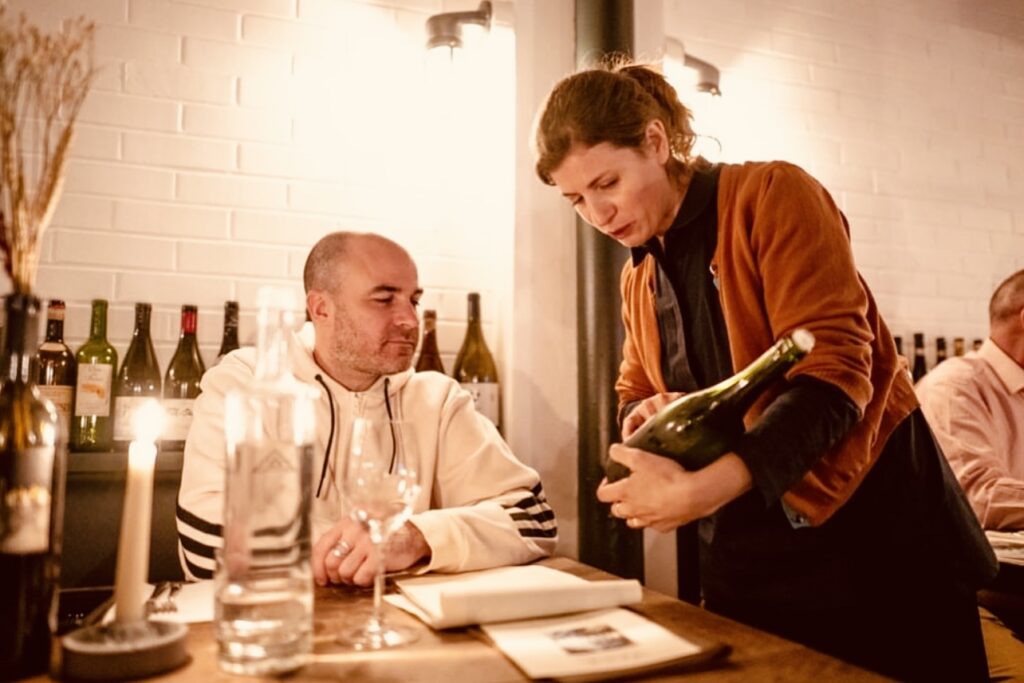
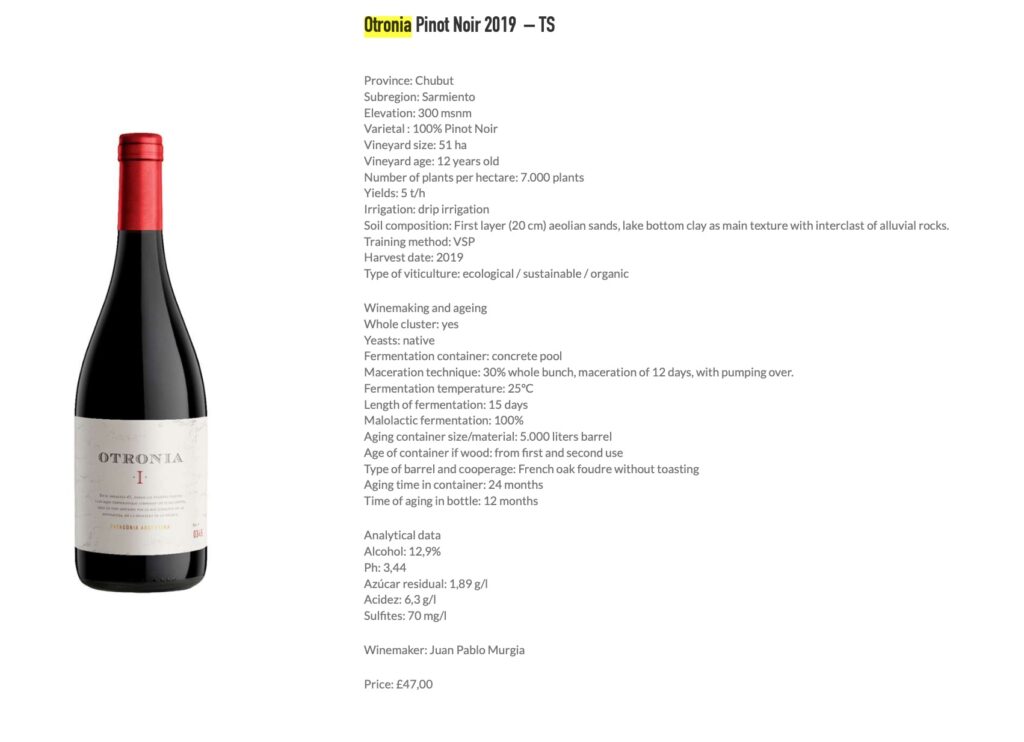
Matias Riccitelli, Bastardo (aka Trousseau) Old Vines from Patagonia RRP £16.00
Paz: This wine comes from one of the most significant winemakers in Argentina today, himself the son of a winemaker, Mateus Riccitelli. The vineyards here are very old and precious – nearly all abandoned. Mateus Riccitelli saw these vineyards and exclaimed ‘What a treasure they have here!’ Mateus doesn’t live in Patagonia but he worked there and became very interested in the region and that is why he is producing these wonderful wines from the old vines there. The winemaking is delicate and the oak is well managed. He wants to show the grape, organically farmed – this is low alcohol for Argentina at 13%, it doesn’t get much more than that and it is balanced and fantastic. I love this wine.
LG: 13% Alcohol. Sensimilla and stinging nettles – texturally, it’s like silk – mouth-watering sour cherry, kirsch, cherry wiśnówka and almond beeswax furniture polish – a gorgeous hint of mandarin on the finish – and tongue drying tannins 93
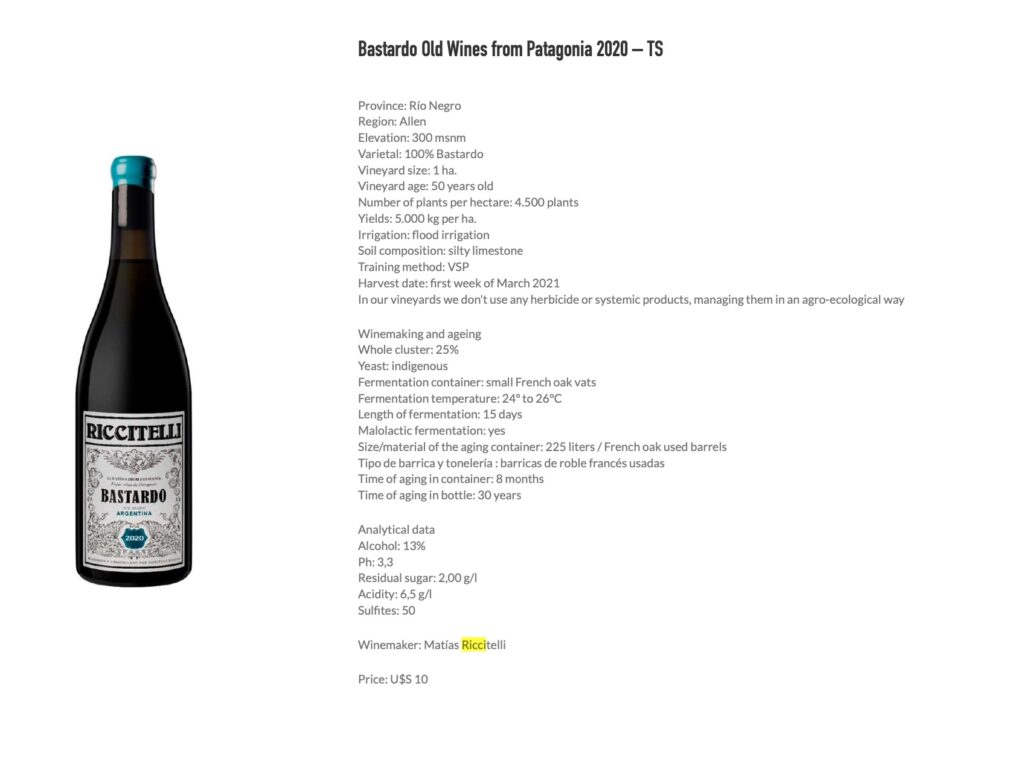
Paz: We follow with this light-coloured structured wine; this comes from another abandoned place in San Juan. Fortunately we have this force, Pancho and I fell in love with this project, you don’t get international consultants, it’s a small village. It was once a very important place, Calingasta with a lot of old mixed Criolla vineyards. You have Moscatel, you have a very particular mixture. He harvested the Listan Prieto to produce this wine. He also has also a single Criolla parcel and Bonarda. He works with low intervention and concrete eggs. When he has time he comes to Tenerife to make wine and also to Spain to understand more about Listan Prieto but he has a bright mind and he makes fantastic wines as you can see. Calingasta, Barreal has traditionally been in the shadows of the bigger regions. Barreal is a village community where Pancho works to have better education in the village, to have more attention in the vineyards, it’s a social project and the wines are fantastic.
Zuccardi and Bugallo, Cara Sur, Criolla 2021, Barreal, Calingasta, San Juan RRP £25.00
LG: 30% whole cluster spontaneously fermented in concrete and aged in 2000L vats for eight months before bottling. Unfined/Unfiltered. Salty, fresh and tart – puckering notes of sour cherry, raspberries, wild strawberries, blackcurrant, blueberries, kirsch, almond and beeswax. Tannins are dry and delicious. Superbly silky 92
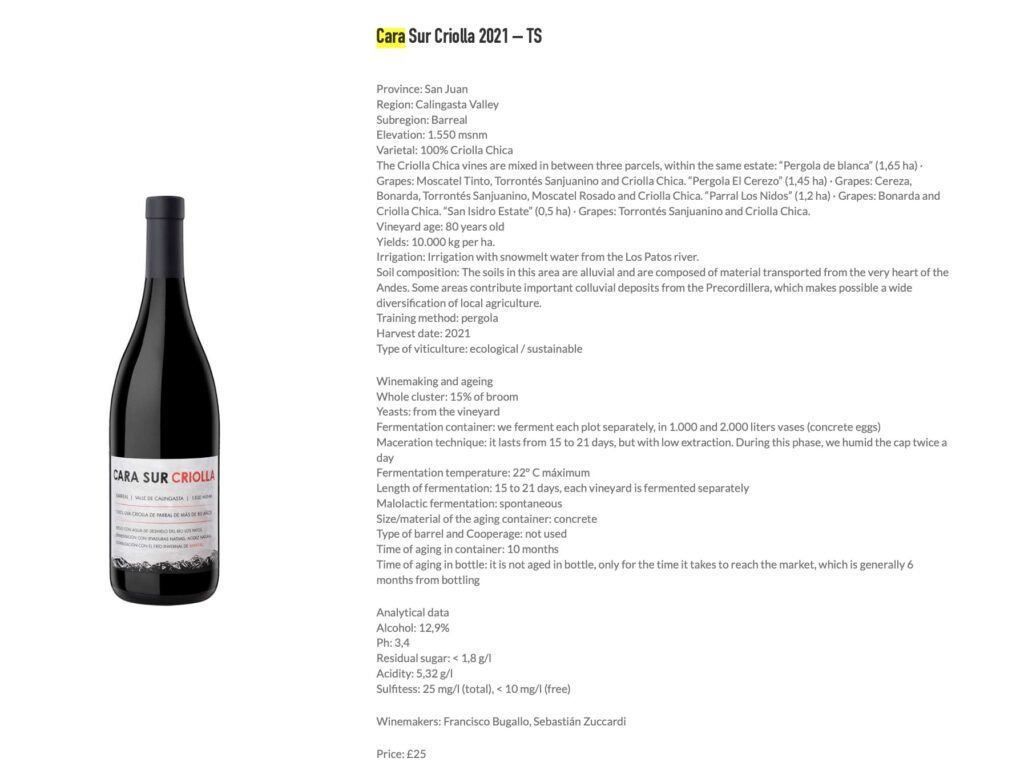
Ver Sacrum, Gloria Garnacha Premium 2019, IG Los Chacayas, Tunuyan, Mendoza RRP £25.00
Paz: We don’t have a tradition of Rhone varietals in Argentina, Ver Sacrum started in 2010 with Rhone varieties by Eduardo Soler, mostly Southern Rhone varieties. They also have Nebbiolo and some Italian grapes. Produced in amphora from 50% whole clusters. It adds a lot of dimension to Argentinian wine. We can have ripeness but here we have structure and freshness. Criolla does not need help for structure. We can say that with many grapes whole cluster adds another dimension, another backbone that was unusual 15, 20 years ago. Also with better winemaking – it’s about the balance and searching for balance in the wines.
LG: Freshly homemade raspberry jam on toast, sour cherry, superbly sapid and savoury with saline. Gloriously long and so pretty 96
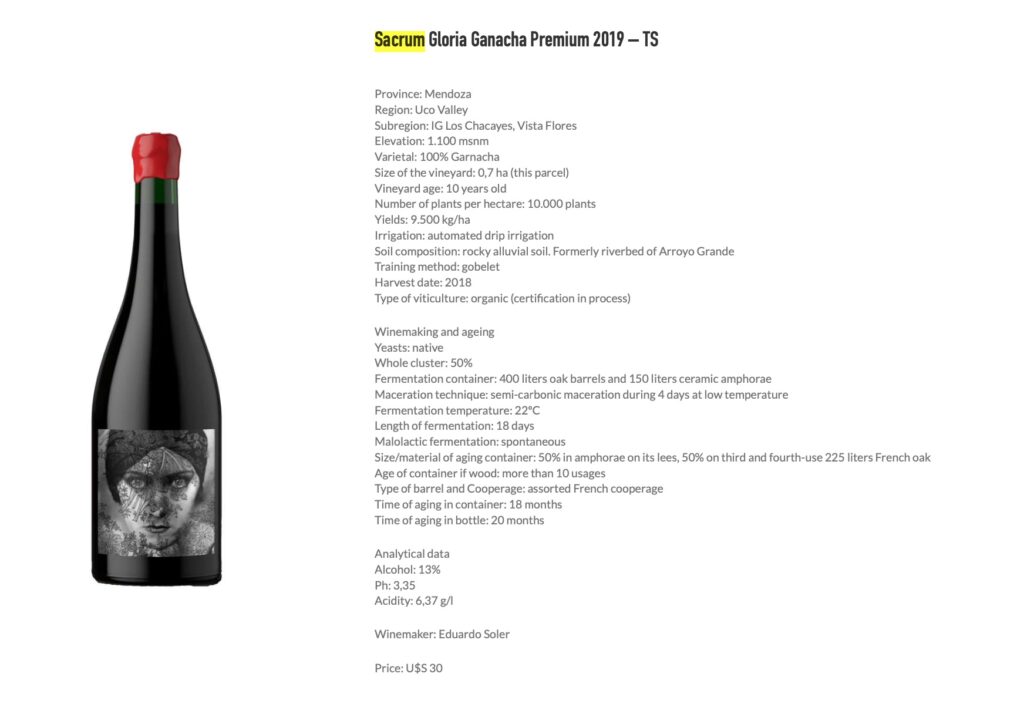
Paz: This is I think one of the best blends for Argentina Malbec and Cabernet Franc are two grapes that get together quite well. These are grown at high altitude. Two sisters who came from a very traditional winery became interested in organic viticulture. We try two contrasting blends – interesting to taste the Malbec blended with other grapes.
Proyecto Hermanas Malbec-Cabernet Franc 2019, Gualtallary and Perdriel, Mendoza RRP £25.00
13.5% Alcohol. 75% Malbec, 25% Cabernet Franc. Bright red fruits and delicate herbal notes. Sapid and delicious. 90
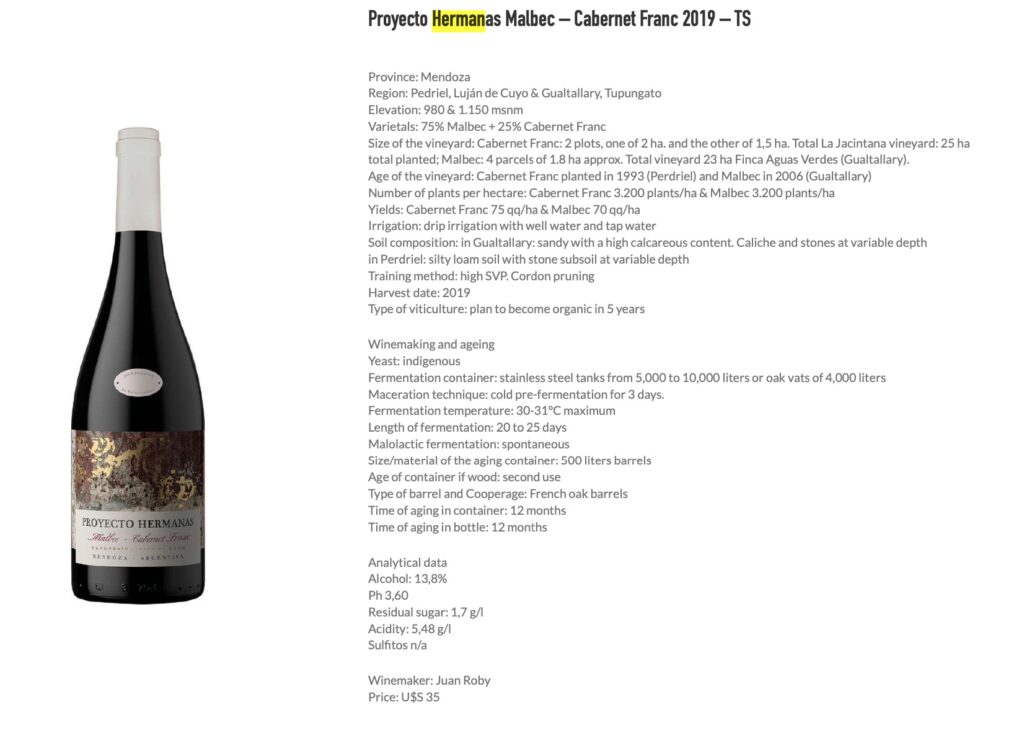
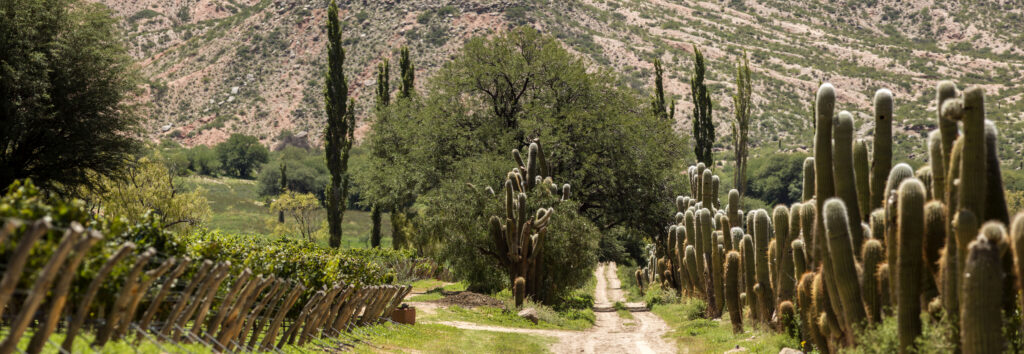
Paz: Now we go to Salta. It’s a very particular wine, unwooded top wines of Argentina. I used to serve this wine, a 99 Tacuil in 2010 because it aged fantastically. It is a special place 2600 m above sea level in Salta. Here you have winemaking indicative of place. There were always rumours that there was also a little bit of Criolla in the blend and I think that is the case. No wood because the father Raol D didn’t want anything that came from outside the region and that’s why the wines are unoaked. High concentration, you have the place speaking – it always have a lot of balance even though its high alcohol. It always a wine that I like, it’s 10% whole cluster Malbec, very old Malbec up there.
It’s not a region that everyone gets to see because it’s very remote, 3 hours from Salta. You have to plan your trip to go there but once you are there it is a really really amazing place. Old pergolas on the older vineyards and you have all this concentration without being heavy and without losing freshness as well. It’s a magical place, the luminosity, the light that they have at 2700 meters above sea level is wonderful. Salta gets a little bit more attention than Rio Negro, I think there are more people working is Salta. It’s a small region. 70% of Argentinian wine comes from Mendoza. There is much more investment in Salta than there is in Rio Negro. I really love these unoaked wines.
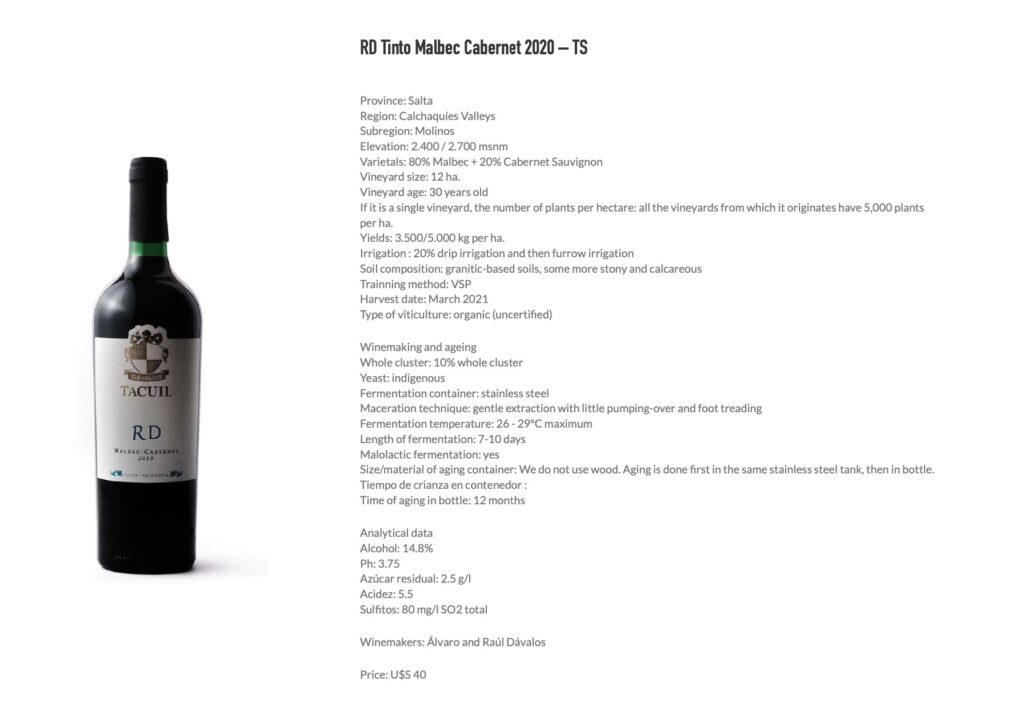
Tacuil, RD 2019, Molinos, Calchaquies Valleys, Salta RRP £33.00
LG: Blackcurrant pastilles, plum, morello cherry, kirsch, sapid and zippy with an extra-long finish and salty notes 92
MALBEC
Paz: Here we are going to Malbec and I often get asked, ‘What will Argentina do after Malbec?’ It’s a strange question because I do not hear people ask, ‘What will Burgundy do after Pinot and Chardonnay?’
In Argentina, in the 50s there was much more Malbec planted than today. We used to have nearly 60k hectares – it wasn’t productive so much of it was uprooted. We preserved 10,000 hectares in the early 90s and began to plant again. We have yet to get to the number of hectares we had before.
I remember in 2012 Pedro Parra came to explore what was happening in the soils of Argentina. Everyone was digging holes to explore what was happening beneath the soil. And as we don’t have appellations or just some appellations, GIs, we are in a moment of really going deep to see what is underneath. Each vineyard you visit there was a study of the soils and this changed everything, it changed viticulture and when you change viticulture you change the quality of the wines.
IRRIGATION
You change also how you irrigate wine because as you know we are experts in irrigation and it’s part of our terroir because irrigation first began with the Incas more than 500 years ago. It’s true that we inherited irrigation in the old area of Mendoza and Cujo, historically here was always a place that was irrigated. To understand the soil you must understand how to irrigate. This is one of the most important things that happened and it started in 2012. You have to start with the vineyards, you can talk about whole clusters but first you must understand the vineyard and how you use your water – use it well and the balance will come to the plant.
Familia Zuccardi, Concreto Malbec 2019, Paraje Altamira, San Carlos, Mendoza RRP 37.00
Sebastian Zuccardi has been doing an amazing job for many years and he is brilliant. He is engaged with viticulture and the winemaking as well. This was one of the first expensive wines to be made without oak. Concreto was the first top wine to go without oak in Mendoza, only in concrete, without epoxy. This was about whole cluster and about doing a naked Malbec, a Malbec that shows the bones and the place. You can do this in Altamira because of these special soils, these alluvial chalk soils. Concreta was a big revolution and that’s why I wanted to put it next to Tacuil, two super wines without oak.
LG: 14% Alcohol. Savoury, structured, gamey, bloody and fragrant, there is a red and black fruit character and an elegant acid line – very fresh and so silky. The tannins and bitey and chewy. 92
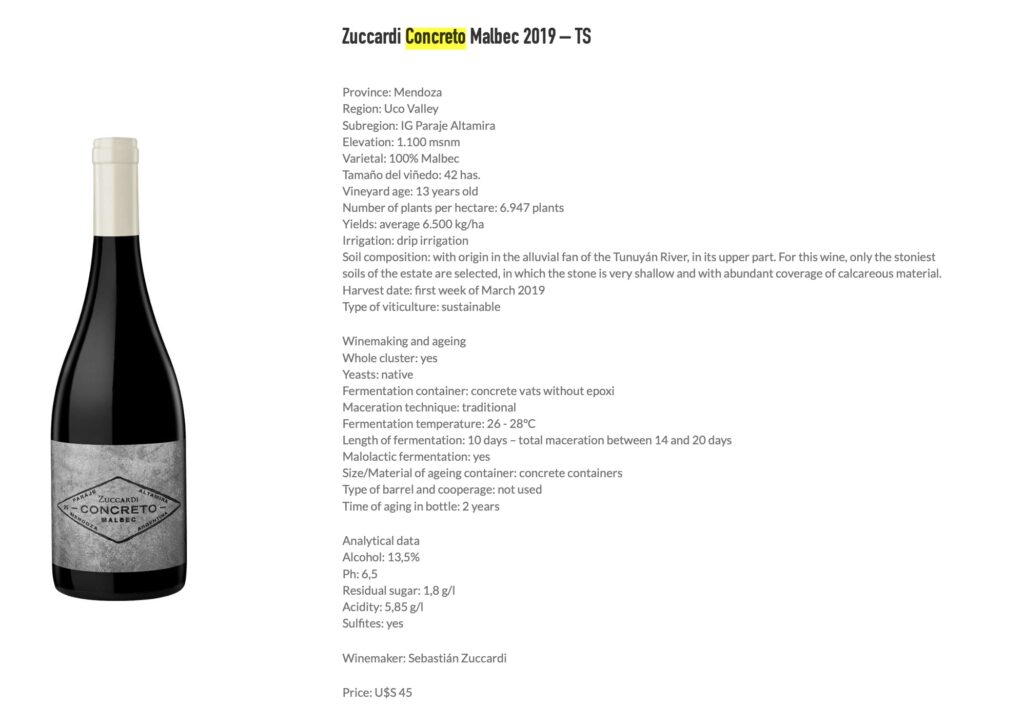
Altos Las Hormigas Malbec Appellation Paraje Altamira 2019, San Carlos, Mendoza RRP £39.00
Paz: I have now placed Altos here because Altos Las Hormigas was one of the key projects with Pedro Parra that started exploring the soil. This is a very important project in Argentina in terms of the studies. They changed so much because for example I could not taste Altos Las Hormigas because it was full of oak and unbalanced. They changed radically, they took away all of the barrels and they put only the large casks. Now in all the traditional wineries you will find only large casks – there was a saying that all of the forest of France were in Argentina. I think that for Malbec, and I think it works far better, big oak format over small.
First now we have a not showy, chalky Malbec with great acidity and freshness and then one with oak, two projects that are working close together. I love these wines.
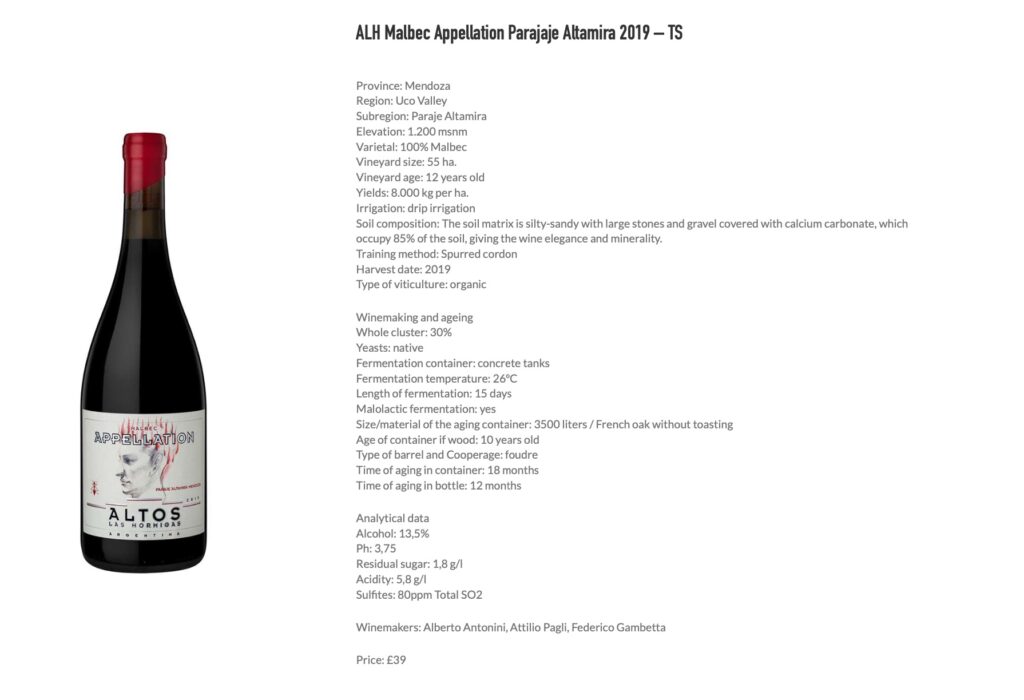
LG: Silky, dry, sapid and with a sublime acid line and fragrant perfumed sour cherry notes. This wine is dense yet light, tense and ready to pounce – a gorgeous upper note of kirsch, plum and black cherry. 93
Paz: Now onto Gualtallary, you have different soils, you have alluvial cones and I want you to taste two wines that are for me among the best producers in Argentina. The Per Se is from very high altitude in Gualtallary. It in the process of becoming a GI, it’s a big place, maybe 2000 hectares so they are planning to divide this place. You also have a lot of difference in altitude, from 100 to 1600, that’s why in a distance to 20km you can have the temperature of Tuscany or the temperature of Burgundy. The higher you go, the cooler it gets but less diurnal range. We need the possibility of gaining the sugar more slowly without losing the acidity so here Per Se which is made by Edy del Popolo a small solo project and they were one of the first to plant in a space that was not flat. Per Se has a lot of difference in the terroir, slopes and they planted en gobolet, Malbec, Cabernet Franc, Syrah and Chardonnay. They produce some of the best wines in Gualtallary.
One of the first vineyards that was planted in Gualtallary was Catena’s Adriana Vineyard but here we are going higher. We speak a lot about quality and wines that are able to age, wines with sharp texture, garrigue and I like these two wines. Superuco is made by the four Michellini brothers and this wine, it’s fantastic. With better irrigation and wine making management, you start to see the effect of the harvest. When I started to study everyone said, no every year is the same, you have the sun, today we can speak about the difference in the vintages.
‘Today we are lucky to taste a lot of 19 which was an excellent vintage, 18 was a little bit warmer but I think we started to talk more and more about the differences between vintages. Actually it’s not classic at all, we take a huge percentage of whole cluster but when we destem we don’t crush, that whole berry with soft skin contact, we try to preserve the floral elements. Super gentle and we don’t crush. We don’t want to extract too much; with high altitude Malbec’s you have to be careful how much you extract because you can go from one profile to a different profile. So we are as gentle as we can be. The climate is a big big deal in Argentina, it effects a lot the culture.‘
‘Superuco is a project of my father and three brothers, there are three brothers, they are the third generation. The idea of the project is to make a school of all the second and third generations of the family. So when one Michellini wants to start a new project he must work at least a year in the field and in the winery of that project. Because one of the ideas was to make that school with two concepts, biodynamic and to make one of the most high-quality projects of the family. So then if they want to make their own project they must first do this. This vintage was made with me and my cousins. The vineyard is registered with Demeter and we produced different parcels from the whole valley, taking grapes from Gualtallary, Tumujan and San Carlos, trying to express with a Superuco view. We produce a bit more of a classical style of wine. We can’t produce a super classic style of wine because we don’t know how..Its 100% Malbec’.
Manuel Michelini Argentina Reloaded 2022
Per Se, Volare del Camino 2018 Monasterio, Gualtallary, Tupungato, Valle de Uco RRP £70.00
LG: Notes of cooling restorative green herbs, damp soil and weighted silk. Kirsch, cherry wiśnówka – super dry with powdery tannins – Crunchy, sapid and delicious. 95
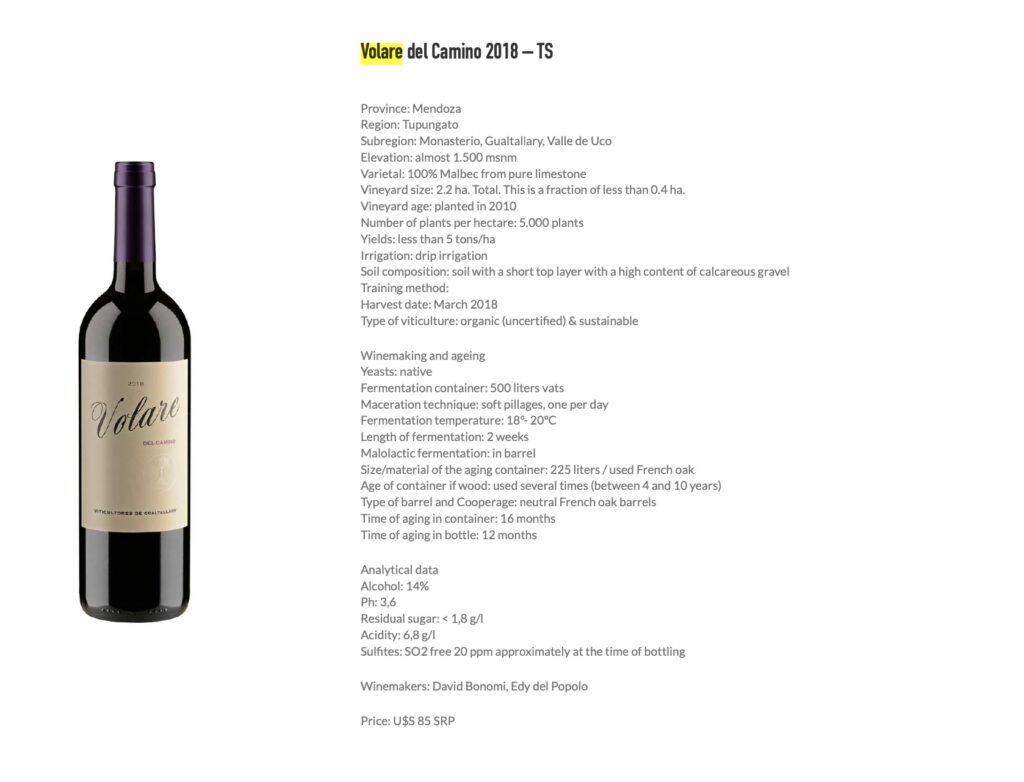
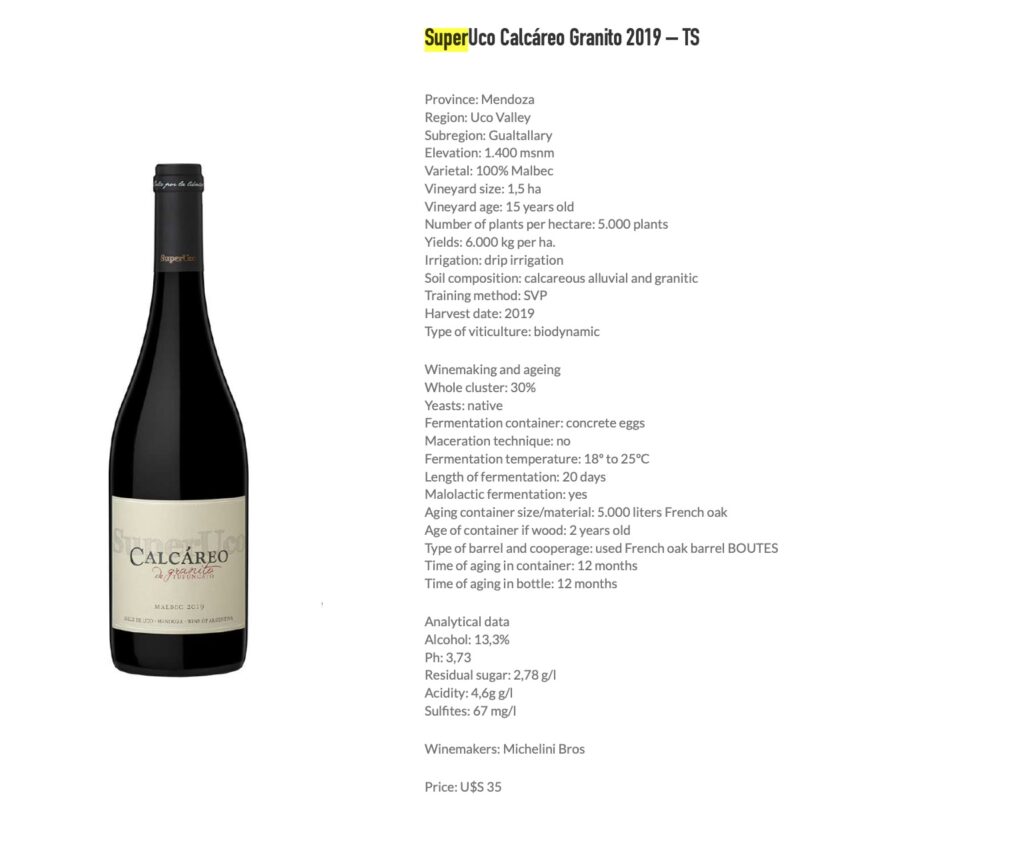
Superuco, Calcáreo Granito 2019, Gualtallary, Tupengato, Mendoza
LG: Full and ripe on the nose with pregnant plum, redcurrants and sour cherry. Fantastic acidity and freshness with bitey chalky tannins 94
Paz: Uspallata is a new region, only 5 hectares planted, I wanted to show you this to show you how it is expanding. It a very remote place at 2000 m above sea level. It was 2018 and it was a warm vintage. A lot of viticultural work and exploration has happened here. More vintages we taste of this vineyard, the more interesting it gets. At altitude they produce very very small quantities of grapes.
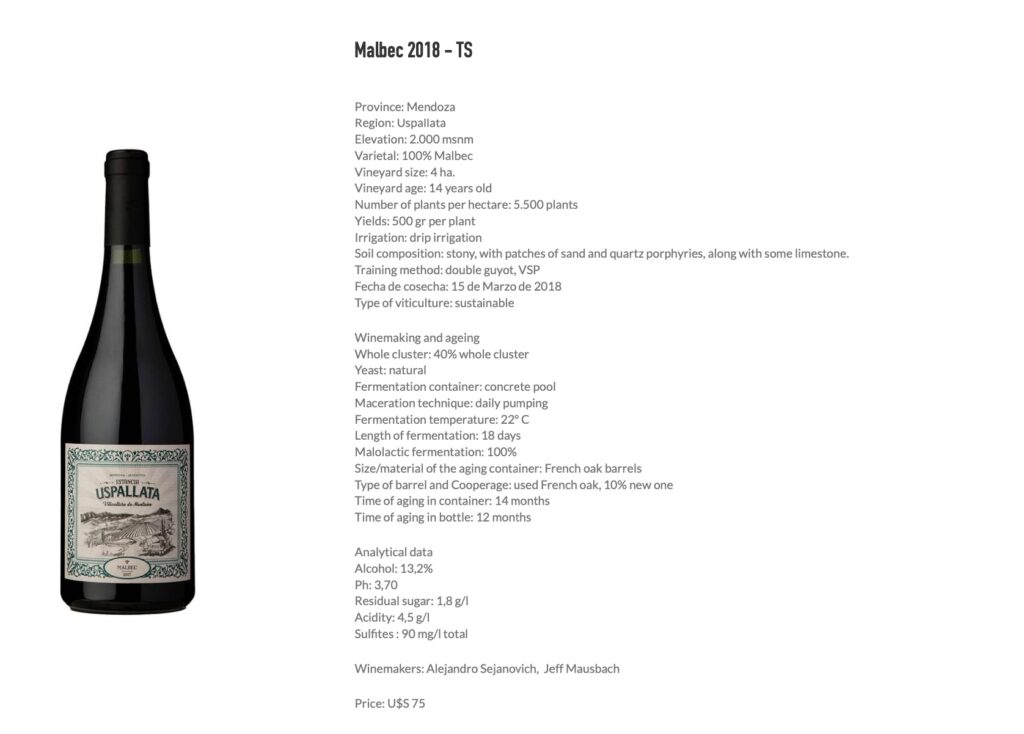
Estancia Uspallata, Malbec 2018, Mendoza
LG: Plummy velvet depths – drowning level deep – rich ripe fruit, thyme and sweet cherry blossom – fresh young blood and salty grippy tannins 95
Paz: The last wine is also at altitude but in Salta at 1800 meters. High density en gobelet planting. This is a very stressful place and produces wines with a lot of freshness and texture, of excellent quality. They use 1000 litre foudres and their winemaker is Francisco Pouvre who is an expert on the region. This is a very balanced Malbec with a lot of freshness because of the altitude.
I wanted to show you the diversity Argentina has to offer.
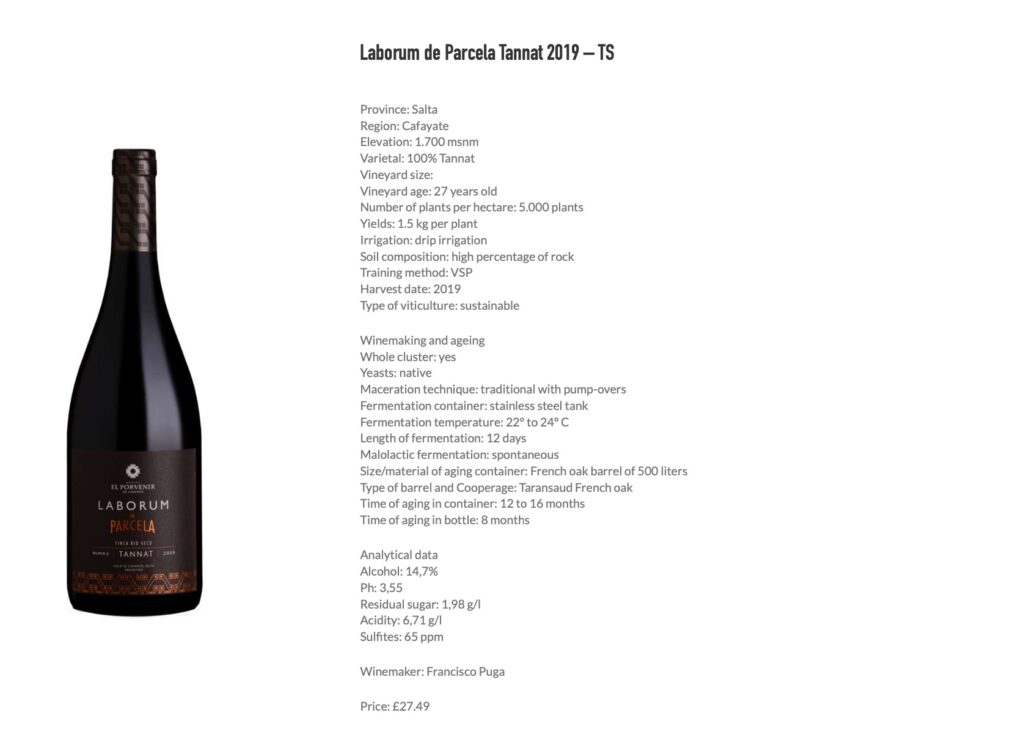
El Porvenir de Cafayate, Laborum de Parcela, Altos los Cuises Malbec 2019 RRP £55.00
LG: Salty soy and caramelised char siu pork, game, blood, plum and cherry unite to form a smorgasbord of intense aromas and flavours, everything from sweet blossom, thyme and cherry to saline savouries. Gorgeously fresh acidity. 93
